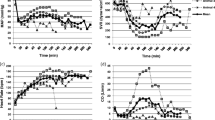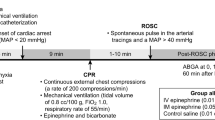Abstract
Intravenous lipid emulsion (ILE) is an adjunctive antidote used in selected critically ill poisoned patients. These patients may also require administration of advanced cardiac life support (ACLS) drugs. Limited data is available to describe interactions of ILE with standard ACLS drugs, specifically epinephrine. Twenty rats with intra-arterial and intravenous access were sedated with isoflurane and split into ILE or normal saline (NS) pretreatment groups. All received epinephrine 15 μm/kg intravenously (IV). Continuous mean arterial pressure (MAP) and heart rate (HR) were monitored until both indices returned to baseline. Standardized t tests were used to compare peak MAP, time to peak MAP, maximum change in HR, time to maximum change in HR, and time to return to baseline MAP/HR. There was a significant difference (p = 0.023) in time to peak MAP in the ILE group (54 s, 95 % CI 44–64) versus the NS group (40 s, 95 % CI 32–48) and a significant difference (p = 0.004) in time to return to baseline MAP in ILE group (171 s, 95 % CI 148–194) versus NS group (130 s, 95 % CI 113–147). There were no significant differences in the peak change in MAP, peak change in HR, time to minimum HR, or time to return to baseline HR between groups. ILE-pretreated rats had a significant difference in MAP response to epinephrine; ILE delayed the peak effect and prolonged the duration of effect of epinephrine on MAP, but did not alter the peak increase in MAP or the HR response.


Similar content being viewed by others
References
Turner-Lawrence DE, Kerns W II (2008) Intravenous fat emulsion: a potential novel antidote. J Med Toxicol 4:109–114
Picard J, Ward SC, Zumpe R, Meek T, Barlow J, Harrop-Griffiths W (2009) Guidelines and the adoption of ‘lipid rescue’ therapy for local anaesthetic toxicity. Anaesthesia 64(2):122–125
Weinberg G, Ripper R, Feinstein DL, Hoffman W (2003) Lipid emulsion infusion rescues dogs from bupivacaine-induced cardiac toxicity. Reg Anesth Pain Med 28(3):198–202
Weinberg GL, VadeBoncouer T, Ramaraju GA, Garcia-Amaro MF, Cwik MJ (1998) Pretreatment or resuscitation with a lipid infusion shifts the dose–response to bupivacaine-induced asystole in rats. Anesthesiology 88(4):1071–1075
Bania TC, Chu J, Perez E, Su M, Hahn IH (2007) Hemodynamic effects of intravenous fat emulsion in an animal model of severe verapamil toxicity resuscitated with atropine, calcium, and saline. Acad Emerg Med 4(2):105–111
Perez E, Bania TC, Medlej K, Chu J (2008) Determining the optimal dose of intravenous fat emulsion for the treatment of severe verapamil toxicity in a rodent model. Acad Emerg Med 15(12):1284–1289
Cave G, Harvey MG, Castle CD (2006) The role of fat emulsion therapy in a rodent model of propranolol toxicity: a preliminary study. J Med Toxicol 2(1):4–7
Niiya T, Litonius E, Petaja L, Neuvonen PJ, Rosenberg PH (2010) Intravenous lipid emulsion sequesters amiodarone in plasma and eliminates its hypotensive action in pigs. Ann Emerg Med 56(4):402–408, e2
Harvey M, Cave G (2007) Intralipid outperforms sodium bicarbonate in a rabbit model of clomipramine toxicity. Ann Emerg Med 49(2):178–185, 185 e1-4
Weinberg G, Di Gregorio G, Hiller D, Hewett A, Sirianni AG (2009) Reversal of haloperidol-induced cardiac arrest by using lipid emulsion. Ann Intern Med 150(10):737–738
Castanares-zapatero D, Wittebole X, Huberlant V, Morunglav M, Hantson P (2012) Llipid emulsion as rescue therapy in lamotrigine overdose. J Emerg Med 42(1):48–51
Finn SD, Uncles DR, Willers J, Sable N (2009) Early treatment of a quetiapine and sertraline overdose with intralipid. Anesthesia 64(2):191–194
Sirianni AJ, Osterhoudt KC, Calello DP, Muller AA, Waterhouse MR, Goodkin MB, Weinberg GL, Henretig FM (2008) Use of lipid emulsion in the resuscitation of a patient with prolonged cardiovascular collapse after overdose of bupropion and lamotrigine. Ann Emerg Med 51(4):412–415, 415 e1
Lange DB, Schwartz D, Daroza G, Gair R (2012) Use of intravenous lipid emulsion to reverse central nervous system toxicity of an iatrogenic local anesthetic overdose in a patient on peritoneal dialysis. Ann Pharmacotherapy. doi:10.1345/aph.1R298
Hiller DB, Gregorio GD, Ripper R, Kelly K, Massad M, Edelman L, Edelman G, Feinstein DL, Weinberg GL (2009) Epinephrine impairs lipid resuscitation from bupivacaine overdose: a threshold effect. Anesthesiology 111(3):498–505
Biddle NL, Gelb AW, Hamilton JT (1995) Propofol differentially attenuates the responses to exogenous and endogenous norepinephrine in the isolated rat femoral artery in vitro. Anesth Analg 80(4):793–799
Chen MH, Lu JY, Xie L, Zheng JH, Song FQ (2010) What is the optimal dose of epinephrine during cardiopulmonary resuscitation in a rat model? Am J Emerg Med 28(3):284–290
McCaul CL, McNamara PJ, Engelberts D, Wilson GJ, Romaschin A, Redington AN, Kavanagh BP (2006) Epinephrine increases mortality after brief asphyxial cardiac arrest in an in vivo rat model. Anesth Analg 102(2):542–548
Mazoit JX, Le Guen R, Beloeil H, Benhamou D (2009) Binding of long-lasting local anesthetics to lipid emulsions. Anesthesiology 110(2):380–386
Huang JM, Xian H, Bacaner M (1992) Long-chain fatty acids activate calcium channels in ventricular myocytes. Proc Natl Acad Sci USA 89(14):6452–6456
Stehr SN, Ziegeler JC, Pexa A, Oertel R, Deussen A, Koch T, Hubler M (2007) The effects of lipid infusion on myocardial function and bioenergetics in l-bupivacaine toxicity in the isolated rat heart. Anesth Analg 104(1):186–192
Rothschild L, Bern S, Oswald S, Weinberg G (2010) Intravenous lipid emulsion in clinical toxicology. Scand J Trauma Resusc Emerg Med 18:51
Van de Velde M, Wouters PF, Rolf N, Van Aken H, Flameng W, Vandermeersch E (1996) Long-chain triglycerides improve recovery from myocardial stunning in conscious dogs. Cardiovasc Res 32(6):1008–1015
Epinephrine. In: Drug bank—open data drug and target data bank. Genome Alberta & Genome Canada. http://www.drugbank.ca/drugs/db00668. Accessed 14 Feb 2012
Mcevoy G, Miller J (eds) (2008) Epinephrine. AHFS drug information. Authority of the Board of the American Society of Health-System Pharmacists, Bethesda, MD, pp 1377–1382
Guimaraes S, And Moura D (2001) Vascular adrenoceptors: an update. Pharmacol Rev 53(2):319–356
Rahman S, Li J, Bopassa JC, Umar S, Iorga A, Partownavid P, Eghbali M (2011) Phosphorylation of gsk-3beta mediates intralipid-induced cardioprotection against ischemia/reperfusion injury. Anesthesiology 115(2):242–253
Haastrup AT, Stepniakowski KT, Goodfriend TL, Egan BM (1998) Intralipid enhances alpha1-adrenergic receptor mediated pressor sensitivity. Hypertension 32(4):693–698
Steinberg HO, Tarshoby M, Monestel R, Hook G, Cronin J, Johnson A, Bayazeed B, Baron AD (1997) Elevated circulating free fatty acid levels impair endothelium-dependent vasodilation. J Clin Invest 100(5):1230–1239
Lopaschuk GD, Ussher JR, Folmes CD, Jaswal JS, Stanley WC (2010) Myocardial fatty acid metabolism in health and disease. Physiol Rev 90(1):207–258
Acknowledgments
Funding for the study was generously provided by University Emergency Medicine Foundation via a resident scholarly development grant. Support for study logistics was provided by Dr. Francesca Beaudoin. Statistical support was provided by Dr. Jason Machan. Evelyn Tolbert, Dr. Lance Dworkin, and Scott McAllister provided procedural training and technical assistance.
Funding Source
University Emergency Medicine Foundation resident scholarly development grant
Author information
Authors and Affiliations
Corresponding author
Additional information
This data was presented in abstract form at the New England Regional Society of Academic Emergency Medicine Conference, Springfield, MA, USA on March 21, 2012 and the Society of Academic Emergency Medicine 2012 Annual Meeting, Chicago, IL, USA on May 12, 2012.
Rights and permissions
About this article
Cite this article
Carreiro, S., Blum, J., Jay, G. et al. Intravenous Lipid Emulsion Alters the Hemodynamic Response to Epinephrine in a Rat Model. J. Med. Toxicol. 9, 220–225 (2013). https://doi.org/10.1007/s13181-013-0291-1
Published:
Issue Date:
DOI: https://doi.org/10.1007/s13181-013-0291-1




